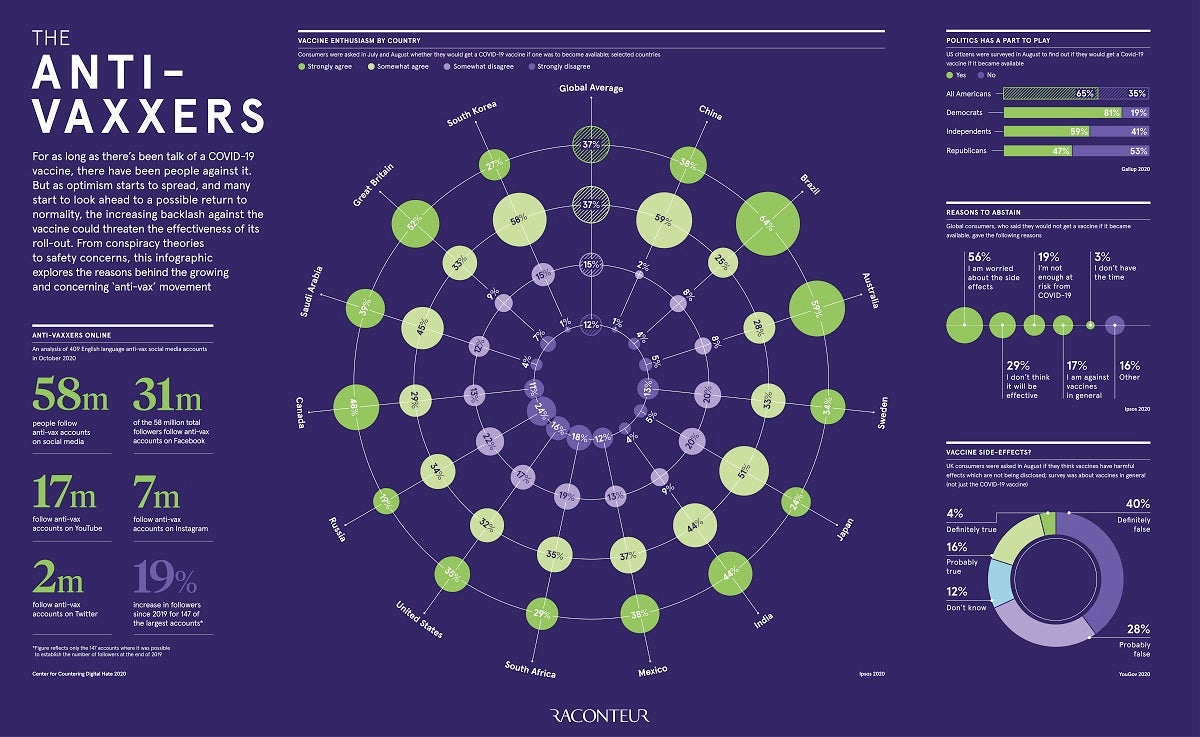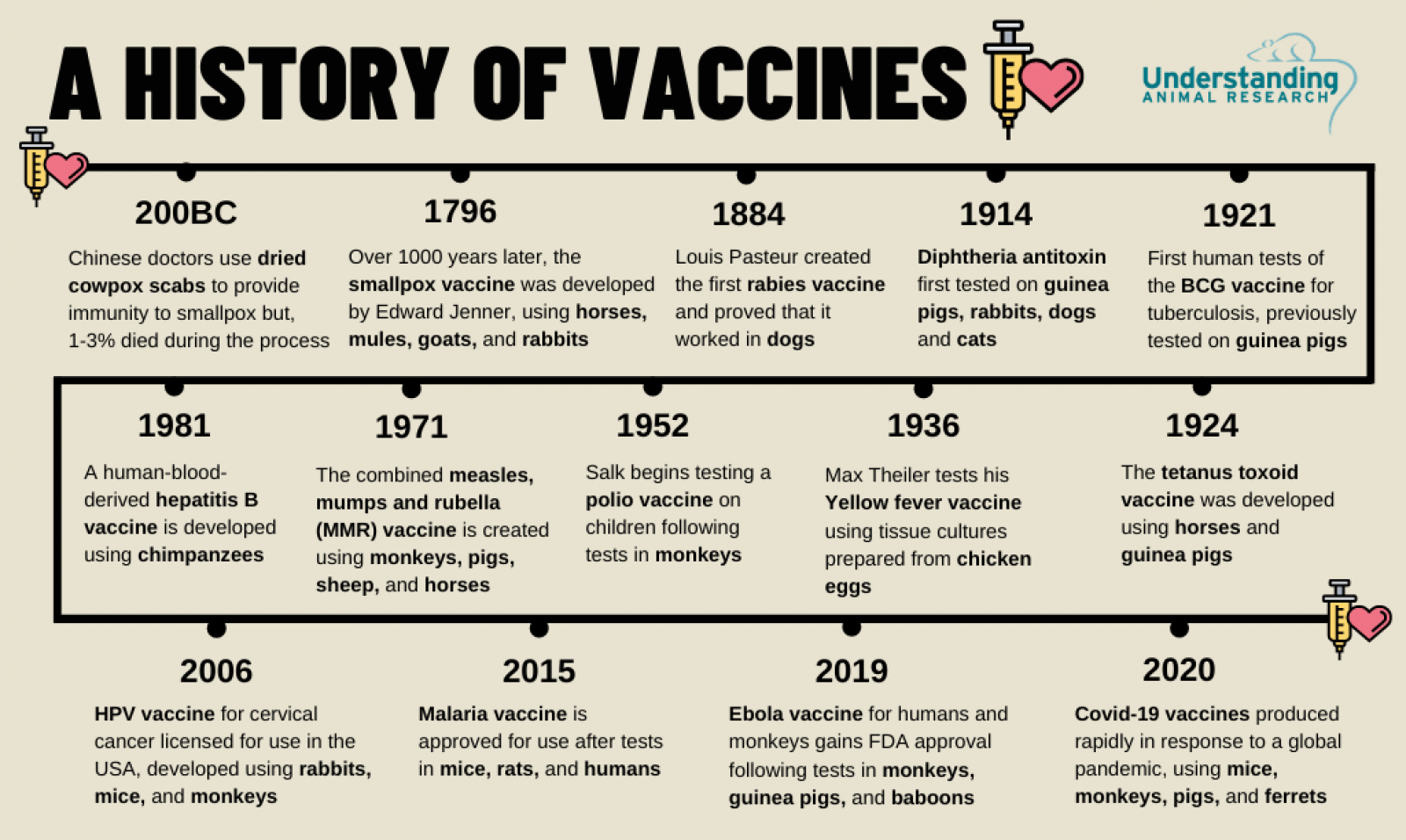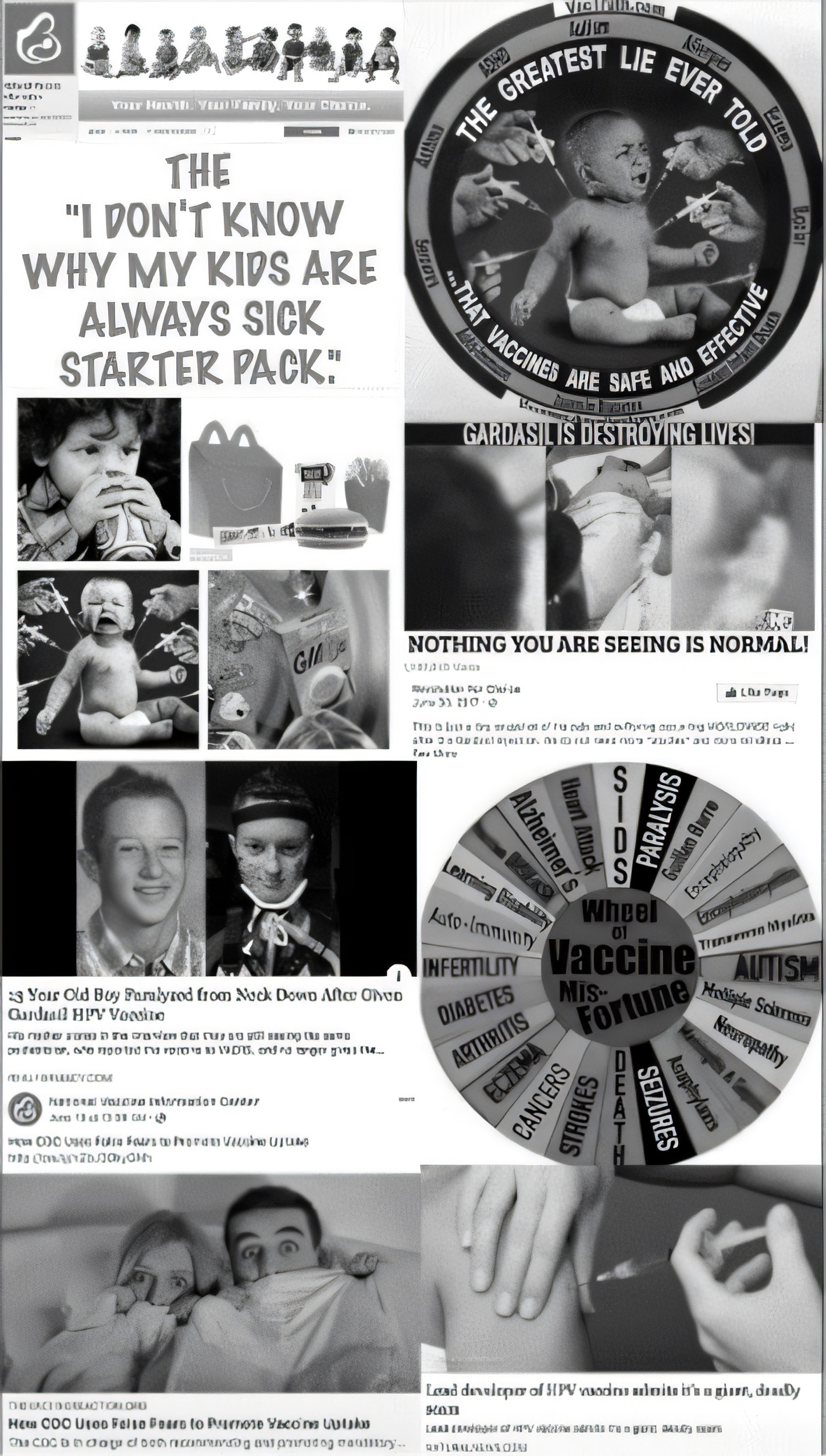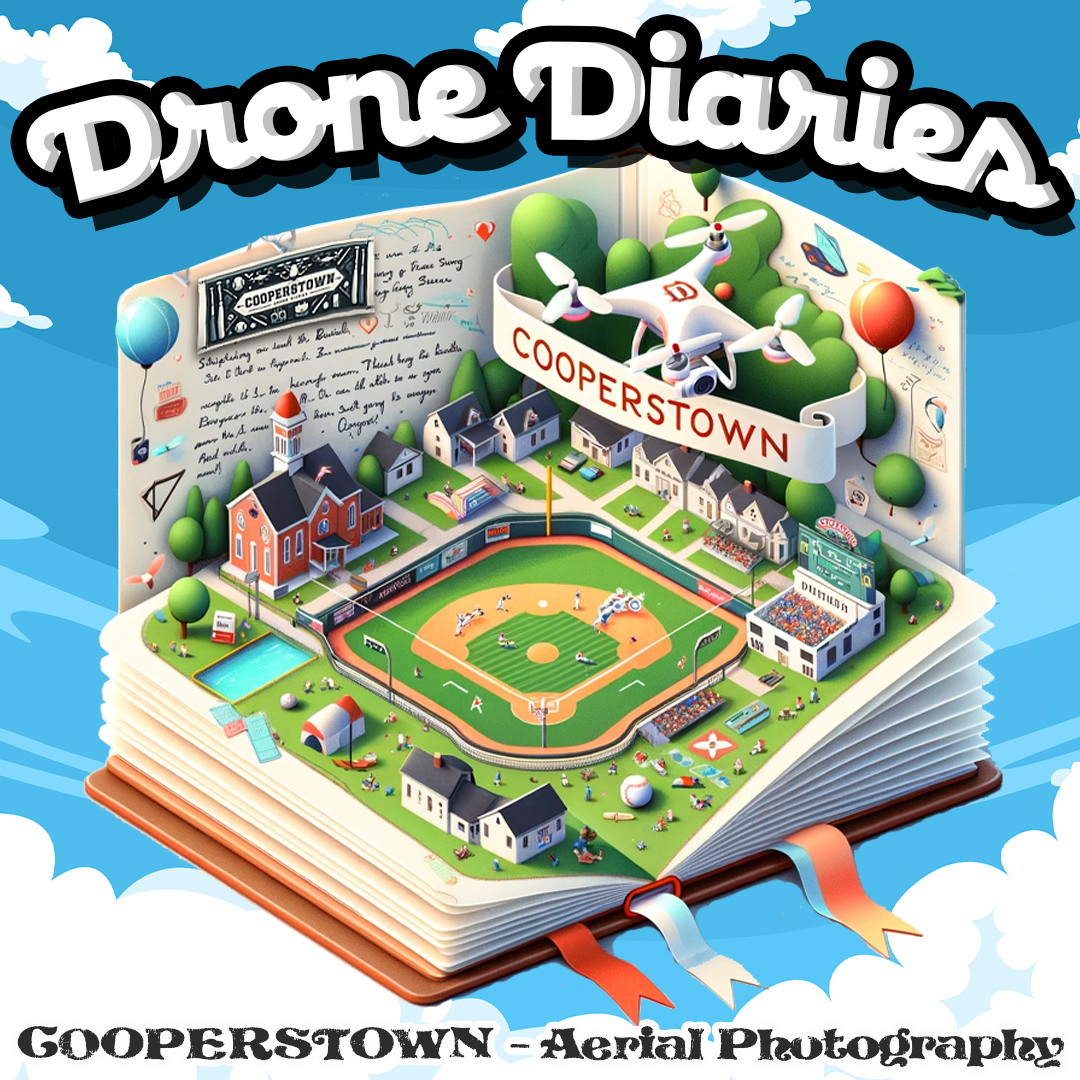TL;DR Summary
The debate over vaccines and their alleged link to autism is deeply polarizing, despite the overwhelming scientific consensus rejecting a causal connection. Autism diagnoses have risen significantly over the past five decades, coinciding with an expanded vaccine schedule, leading some to question whether vaccines might play a role. Proponents of this link cite concerns about vaccine ingredients like aluminum and thimerosal, immune system activation, and potential neuroinflammatory effects during critical brain development periods.
Critics of this perspective point to large-scale studies affirming vaccine safety and emphasize that correlation does not equal causation. However, distrust in pharmaceutical companies, historical scandals, and anecdotal evidence from parents fuel skepticism. Advocates argue that the debate requires open dialogue and unbiased scrutiny to restore public trust and address lingering doubts. Science must remain open to challenging questions, even if the consensus holds.
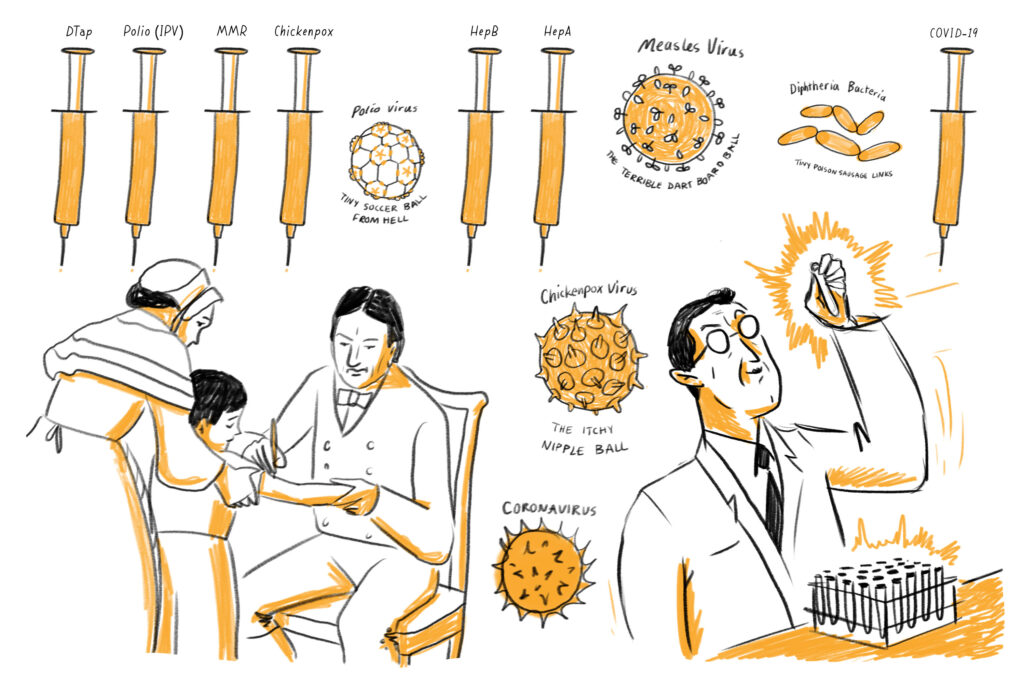
There are few topics more polarizing than vaccines and their potential link to autism. Let’s begin by stating a simple truth: in a world of complex systems, there are no free lunches. Vaccines, heralded as one of humanity’s greatest medical triumphs, may also come with hidden costs. Let’s investigate the evidence, challenge assumptions, and explore why this conversation cannot be dismissed as mere pseudoscience.

Now, before we go further, I want to emphasize that the mainstream medical and scientific communities have repeatedly stated that they’ve found no credible, causal relationship between routine childhood vaccinations and autism spectrum disorder. However, exploring the mindset of those advocating a connection, let’s take a look at what evidence do they point to, and how do they frame their case?

To really understand their perspective, we need to break down the storyline, the studies they reference, and the inferences they draw. This should help us understand the intellectual shape of their argument in its strongest form.
Five Decades of Rising Autism Cases
Over the past five decades, autism spectrum disorder (ASD) has transformed from a rarely diagnosed condition to a prominent public health focus. In the 1970s, the estimated prevalence was just 1 in 2,500 children, a figure that seemed almost negligible. Fast forward to 2020, and that number has risen dramatically to 1 in 36 children.
The History of Vaccinations
In the 1970s, infants and young children were typically recommended to receive vaccines for six diseases: smallpox, DTP (diphtheria, tetanus, pertussis), polio, measles, mumps, and rubella.

Over the decades, additional vaccines have been introduced, including hepatitis B (1991), varicella (1995), pneumococcal conjugate (2000), rotavirus (2006), and more recently, maternal RSV vaccination (2023).
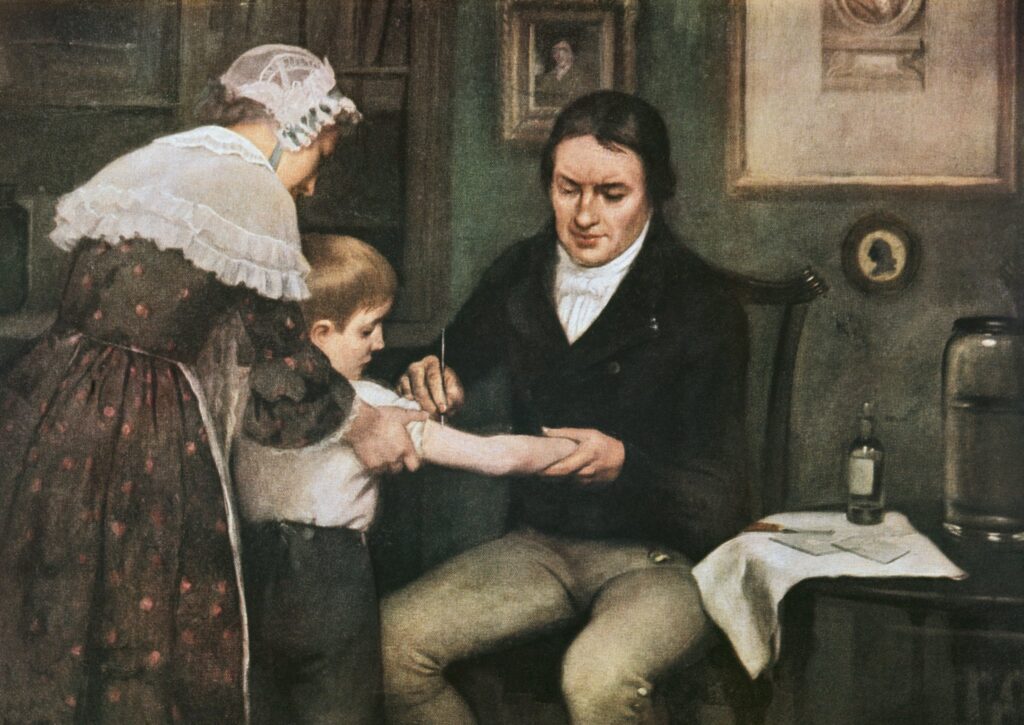
Today, the number of recommended vaccines for infants and young children has increased to approximately 13, reflecting advancements in medical science aimed at protecting against a broader range of bacterial and viral diseases during early childhood.
1970s Recommended Vaccinations:
- Smallpox (phased out by 1972)
- DTP (Diphtheria, Tetanus, Pertussis)
- Polio (Oral Polio Vaccine – OPV/IPV)
- Measles
- Mumps
- Rubella
1980s Additions:
- Hepatitis B (1981): Initially recommended for high-risk groups, marking the beginning of broader vaccine efforts for viral hepatitis.
- MMR Combined Vaccine: The Measles, Mumps, and Rubella vaccines were merged into a single shot for convenience and effectiveness.
- Haemophilus influenzae type b (Hib) (1985): Introduced to prevent bacterial meningitis, a leading cause of childhood mortality.
1990s Additions:
- Hepatitis B (1991): Expanded to all infants shortly after birth.
- Varicella (Chickenpox) (1995): Added to reduce severe cases of chickenpox and complications.
2000s Additions:
Pneumococcal Conjugate Vaccine (PCV7) (2000): To protect against invasive pneumococcal diseases.
Rotavirus (2006): To prevent severe diarrhea and dehydration in infants.
2010s Additions and Updates:
- PCV13 (2010): Replaced PCV7, offering protection against additional strains of pneumococcal bacteria.
2020s Additions:
- COVID-19 Vaccines (2021): Recommended for children, including infants as young as 6 months, to protect against SARS-CoV-2.
- RSV Vaccine (2023): Maternal RSV vaccination to protect newborns.
Comparison: Then vs. Now
In the 1970s, only six vaccines were recommended for infants and young children.

Today, the number has grown to approximately 13, with the inclusion of COVID-19 and RSV vaccines, reflecting ongoing advancements in immunization efforts to address emerging public health threats.
The Case for Concern: Evidence from Biology and Beyond
As skepticism surrounding vaccines grows, a closer look at the biological mechanisms involved provides fuel for those questioning their safety.
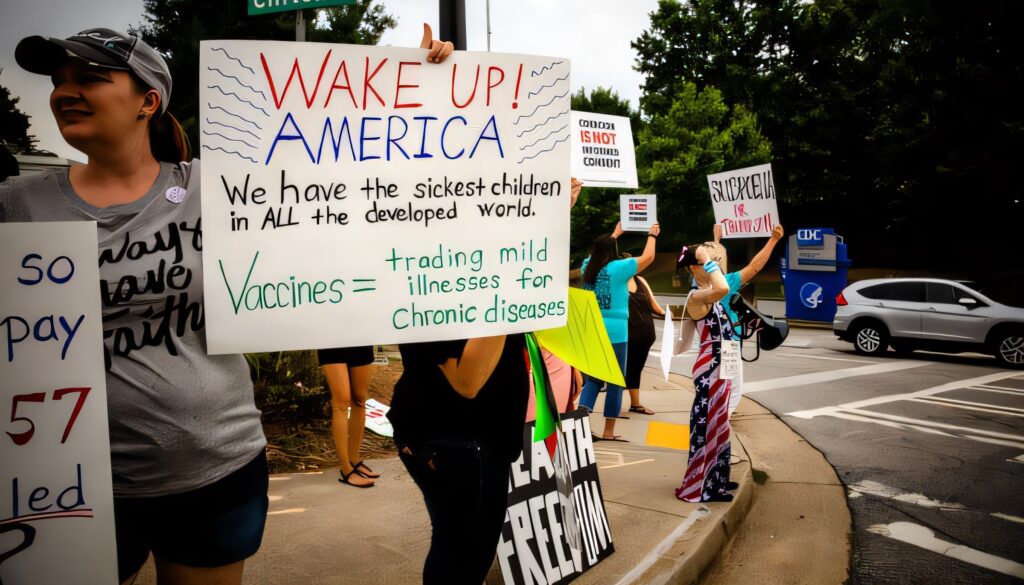
Proponents of the vaccine-autism link argue that specific components in vaccines, their timing, and their effects on the immune system may contribute to neurodevelopmental disorders. The following data points and studies are frequently cited to support this perspective:
Adjuvants: Unnatural Enhancers with Unintended Effects
To boost the immune response, vaccines often include adjuvants like aluminum. There are scientists that argue that aluminum, while effective at provoking immunity, is also a neurotoxin.

Research such as a 2017 study in Frontiers in Neurology have shown that aluminum adjuvants can persist in the body long after vaccination, traveling to various tissues, including the brain. Once aluminum crosses the blood-brain barrier, it may induce a neuroinflammatory response, characterized by the activation of microglial cells (the brain’s immune cells).

Neuroinflammation, particularly during critical periods of brain development, could interfere with processes like synaptic pruning, neuronal connectivity, and myelination. These disruptions are hypothesized to alter the brain’s development, potentially leading to symptoms associated with autism.
Thimerosal and the Mercury Puzzle
Mercury is a well-known neurotoxin. Although thimerosal, a mercury-based preservative, has been removed from most vaccines, it’s worth examining the legacy data. Studies in Science Direct (2020) show that ethylmercury, a component of thimerosal, can accumulate in the brain and affect cellular processes.

The neuroinflammatory cascades this initiates may intersect with critical developmental windows, particularly in children. The lack of definitive, individually tailored research on at-risk subgroups (for example, children with certain genetic predispositions) leaves open the possibility that we might be missing a subtle but meaningful effect.
Cytokine Storms in the Developing Brain
Vaccines are designed to provoke an immune response, including the release of cytokines. Cytokines, while critical for fighting infections, can also influence brain development.
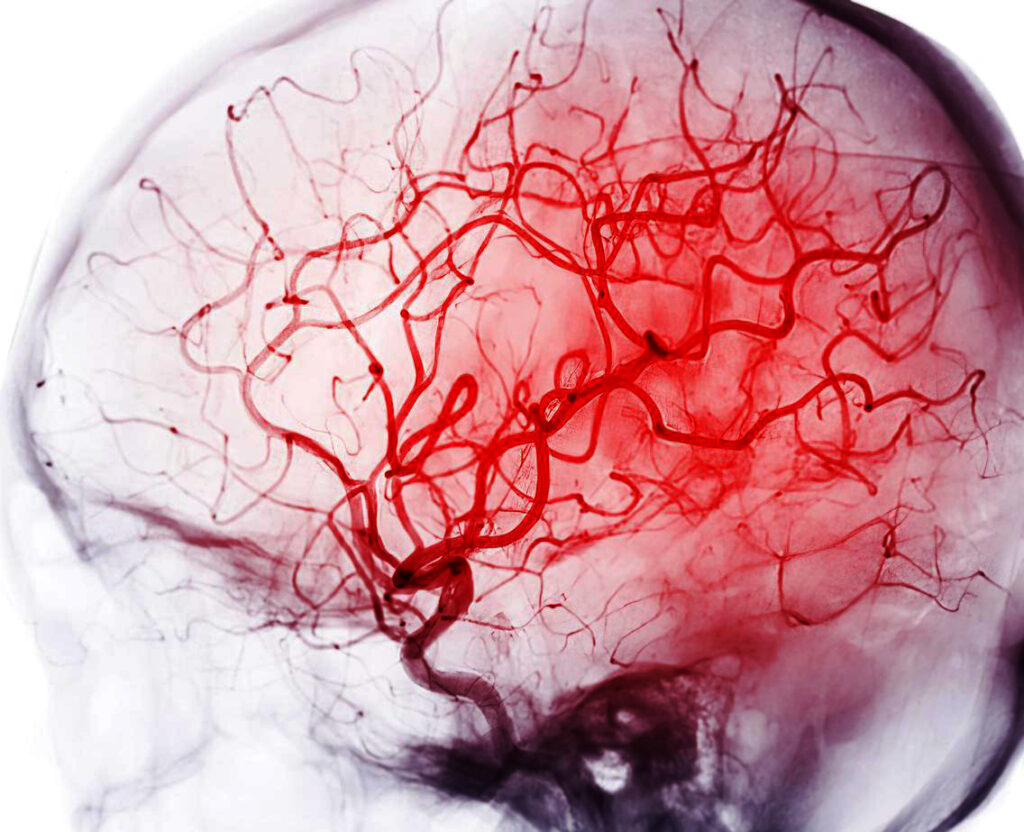
Studies have demonstrated that excessive cytokine activity can interfere with synaptic pruning, a process essential for cognitive function. Could the immune activation induced by vaccines be inadvertently hijacking this system?
At Birth
- Hepatitis B (HepB):
- First dose given shortly after birth.
1–2 Months
- Hepatitis B (HepB):
- Second dose (if not given at 1 month).
2 Months
- Diphtheria, Tetanus, and Acellular Pertussis (DTaP)
- Haemophilus influenzae type b (Hib)
- Inactivated Poliovirus (IPV)
- Pneumococcal Conjugate Vaccine (PCV13)
- Rotavirus (RV):
- (RV1 or RV5, depending on the brand).
4 Months
- DTaP
- Hib
- IPV
- PCV13
- Rotavirus
6 Months
- DTaP
- Hib (depending on the brand)
- IPV
- PCV13
- Rotavirus (depending on the brand)
- Influenza (annually):
- Start with two doses at least 4 weeks apart for the first year of vaccination.
12–15 Months
- Measles, Mumps, and Rubella (MMR)
- Varicella (Chickenpox)
- Hepatitis A (HepA):
- First dose (second dose given 6 months later).
- Hib
- PCV13
15–18 Months
- DTaP
4–6 Years
- DTaP
- IPV
- MMR
- Varicella
11–12 Years
- Tetanus, Diphtheria, and Acellular Pertussis (Tdap)
- Human Papillomavirus (HPV):
- 2 doses if started before 15 years; 3 doses if started at 15 years or older.
- Meningococcal Conjugate Vaccine (MenACWY):
- First dose, with a booster at 16 years.
16–18 Years
- Meningococcal B (MenB):
- Optional, based on shared clinical decision-making.
- COVID-19 Vaccines:
- According to the latest CDC guidelines, appropriate doses based on age and health conditions.
- Annual Influenza Vaccine:
- Recommended every flu season starting at 6 months.
SOURCE: CDC Immunization Schedule.
Individual Variation: The Achilles’ Heel of Epidemiology
Human biology is an evolutionary masterpiece, shaped over millions of years by selective pressures. Intervening in such a finely-tuned system requires immense care. Vaccines are designed to mimic natural infections and elicit an immune response without the associated disease. But what if this artificial stimulation of the immune system has unintended consequences, particularly for neurodevelopment?

Evolution has equipped the immune system to work in concert with other systems, including the brain. Disruptions to this harmony, even well-intentioned ones, could have downstream effects. Autism and other neurodevelopmental disorders may represent such unintended outcomes.
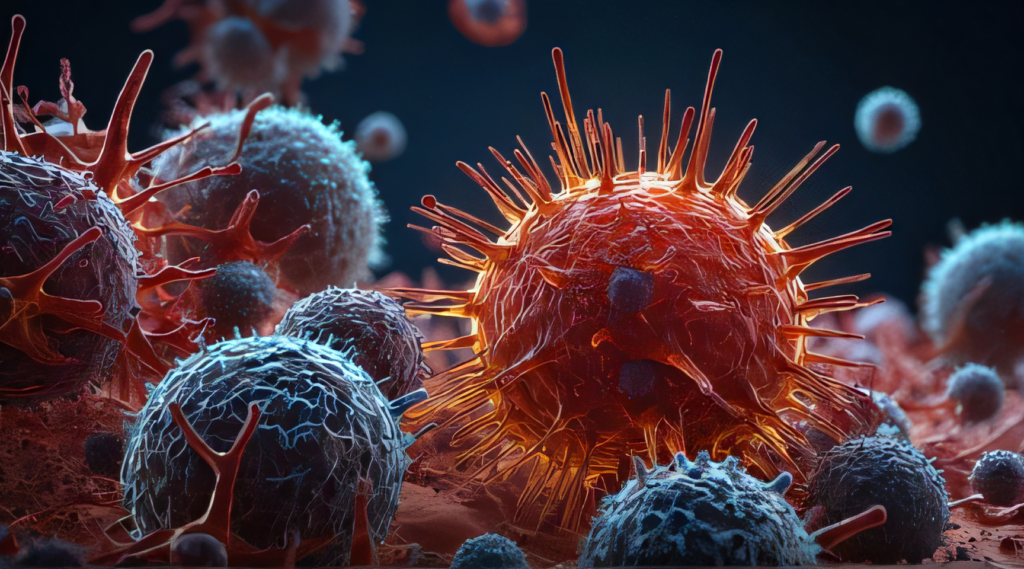
Large-scale studies often conclude that vaccines are safe, but these studies focus on population averages. Evolutionary biology teaches us that populations are heterogeneous. Rare but severe adverse reactions might occur in individuals with specific genetic susceptibilities. For example, children with mitochondrial dysfunction or certain epigenetic markers may be particularly vulnerable.
Deception in Pharma: A Troubled Track Record
Over the years, the pharmaceutical industry has been repeatedly caught misleading the public about the safety and efficacy of their products. From GlaxoSmithKline’s $3 billion settlement for unlawful promotion and concealment of safety data to Purdue Pharma’s role in fueling the opioid crisis with deceptive marketing, these companies have consistently prioritized profit over public health.

More recently, Pfizer and Moderna have faced lawsuits related to COVID-19 vaccines, with allegations of misrepresenting data and infringing on patented technologies. These scandals are not isolated incidents; they paint a consistent picture of an industry willing to distort facts for financial gain. And the scandal of “trust the science’ was the straw that broke the camels back.
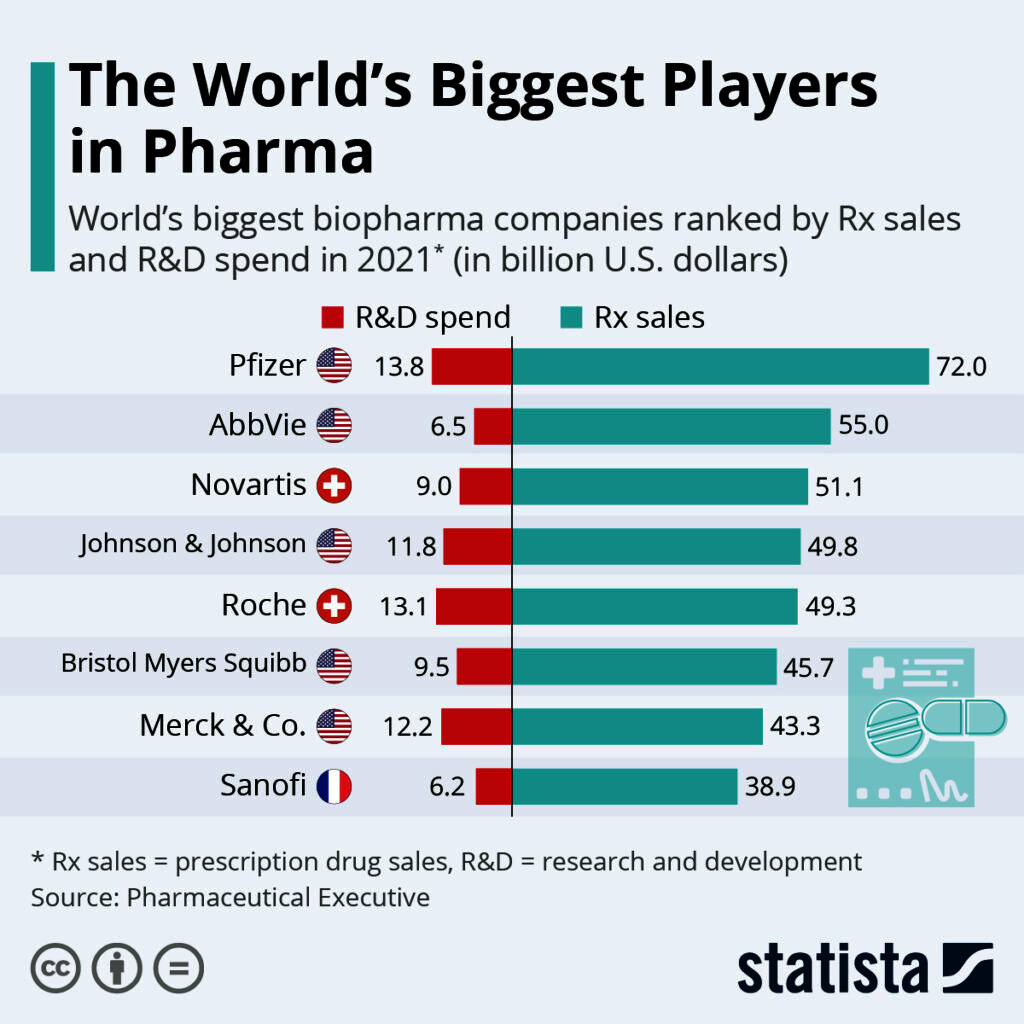
Given this history of deception, it’s not a stretch to consider the possibility that vaccines, too, might have undisclosed risks. If these corporations have misled the public on life-altering issues so many times before for profit, it’s entirely reasonable to scrutinize their claims about vaccine safety. Trust in the pharmaceutical industry has been eroded by their own actions, and their track record suggests that skepticism is not only justified but necessary. And even if the vaccines are safe, big phamra’s history does not help sell that idea.
- GlaxoSmithKline (GSK): Accused of promoting drugs for unapproved uses, failing to report safety data, and misleading consumers about pricing. This resulted in one of the largest settlements in the industry.
- Johnson & Johnson: Faced charges for unlawfully marketing drugs to elderly dementia patients and incentivizing healthcare providers to promote off-label uses of their products.
- Takeda Pharmaceutical: Linked to lawsuits over its diabetes drug Actos, accused of hiding the risks of bladder cancer from patients and regulators.
- Purdue Pharma: Played a central role in the opioid crisis, allegedly downplaying the addictive risks of OxyContin while encouraging widespread prescription, which led to one of the largest settlements in history.
- Teva Pharmaceuticals: Accused of manipulating drug prices and using kickbacks disguised as charitable donations, resulting in significant penalties.
- COVID-19 Vaccine-Related Cases: Recent controversies have arisen surrounding COVID-19 vaccines, with claims of misrepresented efficacy and concealed risks. Additionally, patent disputes over vaccine technologies have led to high-profile lawsuits between companies.
These incidents underscore recurring concerns about transparency, ethical practices, and accountability within the pharmaceutical industry.
Vaccines are not just a medical tool; they are a multi-billion-dollar industry. When financial incentives align with public health messaging, it becomes difficult to separate fact from propaganda. Researchers who raise questions about vaccine safety often face ostracism, defunding, or worse. This suppression of dissent stifles the scientific process and undermines public trust.
The Timing of Symptoms: A Pattern Too Common to Ignore
Dismissed by many as anecdotal, the experiences of thousands of parents cannot be so easily waved away. These parents report developmental regressions following vaccination with stories that are strikingly consistent across diverse populations.

While correlation does not imply causation, the temporal proximity raises valid questions. A 2018 paper in the Journal of Immunotoxicology posited that immune activation from vaccines could alter neurodevelopment in genetically predisposed children. In evolutionary terms, these patterns of behavior can suggest that we may be observing the downstream effects of a novel environmental pressure: mass vaccination. While correlation does not imply causation, the temporal proximity raises valid questions.
This is known as “post hoc ergo propter hoc” fallacy, where assuming causation just because one event follows another. But from within the strongman viewpoint
Critics would call this a “post hoc ergo propter hoc” fallacy, where assuming causation just because one event follows another. But from within the strongman viewpoint, coincidence on such a large scale warrants deeper inquiry. If enough parents begin to notice symptoms like avoiding eye contact, babbling, or certain interactive behaviors shortly after an immunization, why shouldn’t that anecdotal evidence spark further scrutiny?
Emotional and Anecdotal Resonance:
Finally, the “strong” version of this argument understands the power of personal stories. When a family shares a heartfelt narrative of a child’s apparent regression into autism soon after a round of shots, data-driven rebuttals can feel cold and unconvincing. Strong proponents emphasize that while anecdotes do not constitute proof, they can point to patterns that large-scale research might fail to detect. They suggest that parents, who intimately know their children, are important “frontline observers” whose experiences should not be discounted.
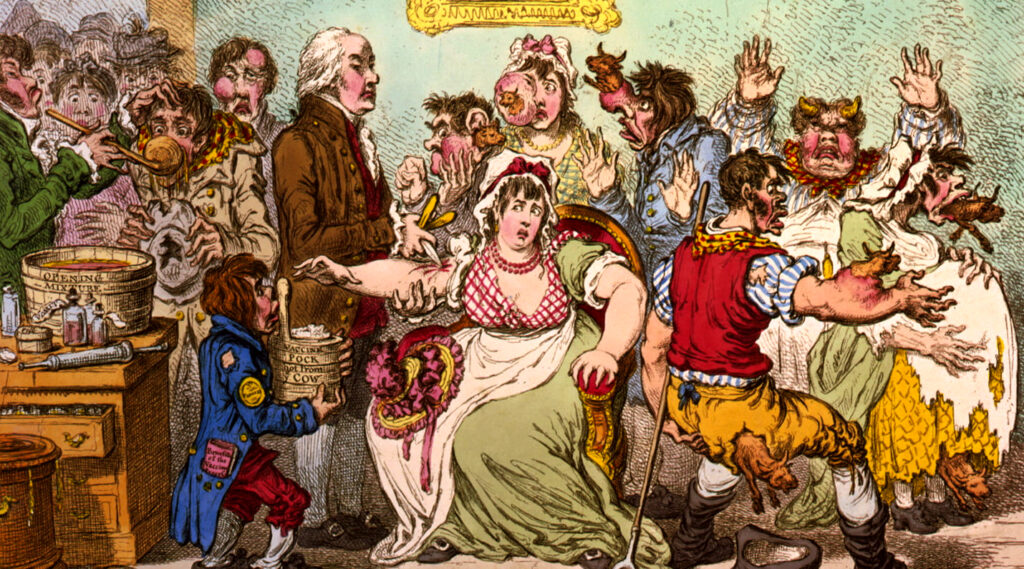
A scene at the Smallpox and Inoculation Hospital at St. Pancras, showing cowpox vaccine being administered to frightened young women, and cows emerging from different parts of people’s bodies; in 1802
When this is combined with studies that people find credible, however challenged or rejected by the broader scientific community they perceive the mainstream consensus as premature or overly influenced by industry stakeholders, thereby sustaining their skepticism. This skepticism is often fueled by alternative narratives that circulate in social media and other platforms, where dissenting opinions can gain traction despite lacking rigorous scientific backing. Additionally, the mainstream media’s impact on public trust cannot be underestimated; sensationalized reporting or perceived biases can further alienate individuals from accepting widely accepted scientific findings. As a result, those who already harbor doubts may become even more entrenched in their beliefs, reinforcing a cycle of skepticism that challenges the efforts of the scientific community to communicate effectively.
Trump’s HHS Nomination Reignites Vaccine Debate
Robert F. Kennedy Jr., a former environmental and toxicology attorney, has long argued that vaccines pose significant risks, citing concerns about ingredients and alleging links to autism and chronic disease. Now, with Donald Trump nominating Kennedy to lead the Department of Health and Human Services, his controversial beliefs are front and center in public discourse.

This unexpected development has sparked renewed conversations about vaccine safety and transparency in health policy. Whether Kennedy’s concerns prove valid or unfounded, this reopening of the dialogue offers a chance to reexamine the issue with fresh scrutiny. By addressing public concerns head-on, hopefully this will strengthen the trust in public health initiatives and settle the debate for good… whichever side the truth lies.
Robert F. Kennedy Jr. often presents evidence that he claims supports his arguments about the dangers of vaccines. Below is a summary of the evidence he has cited for each of his major claims, along with a note on how the scientific community views that evidence:
1. Autism Link
- RFK Jr. references studies and reports, such as a controversial 1998 paper by Dr. Andrew Wakefield that suggested a link between the MMR vaccine and autism. He also cites anecdotal cases from parents and unpublished research.
- He points to increases in autism diagnoses correlating with expanded vaccine schedules.
Counterpoint:
- Wakefield’s study was retracted, and his medical license was revoked due to ethical violations and fraudulent data. Large-scale studies, including those involving millions of children, show no link between vaccines and autism.
2. Toxic Ingredients
- He highlights the presence of thimerosal, aluminum, and formaldehyde in vaccines, pointing to animal studies suggesting neurotoxic effects.
- He references work by researchers like Dr. Boyd Haley, who claimed that mercury exposure could damage neurons.
Counterpoint:
- Thimerosal was removed from most childhood vaccines in the U.S. by 2001, and studies found no differences in autism rates before and after its removal. The amounts of aluminum and formaldehyde in vaccines are small and well below toxic thresholds.
3. Immune System Damage
- He often cites studies suggesting that repeated vaccine exposure may overstimulate or “confuse” the immune system, potentially causing autoimmune conditions.
Counterpoint:
- Vaccines are designed to mimic natural infections without causing disease, strengthening the immune system. There is no credible evidence linking vaccines to autoimmune diseases.
4. Neurological Damage
- He has referenced anecdotal accounts and small studies that purport to link vaccines with neurological issues such as seizures or developmental delays.
- He points to research by Dr. Yehuda Shoenfeld on “autoimmune/inflammatory syndrome induced by adjuvants” (ASIA).
Counterpoint:
- Large-scale studies find no credible evidence of vaccines causing widespread neurological harm. While febrile seizures can occur after some vaccines, they are rare and generally not associated with long-term harm.
5. Chronic Illness
- He highlights correlations between the rise in chronic illnesses like asthma and allergies and the increase in childhood vaccines.
Counterpoint:
- Correlation does not imply causation. Research does not support a causal relationship between vaccines and chronic diseases. Many chronic illnesses have complex genetic and environmental causes.
6. Lack of Proper Testing
- He claims that vaccines are not subjected to the same rigorous double-blind, placebo-controlled trials as drugs and that long-term safety data are lacking.
Counterpoint:
- Vaccines are tested extensively before approval and monitored continuously for safety. Double-blind, placebo-controlled trials for vaccines often use active comparators to avoid ethical issues, and robust post-market surveillance systems are in place.
7. Regulatory Capture
- He points to historical examples of conflicts of interest, such as former pharmaceutical executives working for the CDC or FDA.
Counterpoint:
- While conflicts of interest are a concern in any industry, regulatory agencies are overseen by multiple layers of accountability. Independent reviews and public transparency help ensure vaccine safety.
8. Herd Immunity Myth
- He argues that historical declines in infectious diseases were due to better hygiene, not vaccines, and questions whether herd immunity thresholds are achievable.
Counterpoint:
- Declines in diseases like measles and polio align with vaccine introductions, not just hygiene improvements. Herd immunity is a well-established phenomenon in epidemiology.
9. Increased Vaccine Schedule
- He cites comparisons of historical and modern vaccine schedules, arguing that today’s schedule is excessive and untested for cumulative effects.
Counterpoint:
- Modern vaccine schedules are designed based on robust scientific evidence to protect against preventable diseases. No evidence supports the idea that receiving multiple vaccines overwhelms the immune system.
10. Censorship and Suppression
- He claims that studies questioning vaccine safety are not published due to pressure from pharmaceutical companies and that platforms like social media censor dissenting views.
Counterpoint:
- Peer-reviewed journals require rigorous evidence for publication. Many studies critical of vaccines have methodological flaws or lack reproducibility, leading to rejection for scientific reasons, not censorship.
11. Ethical Concerns
- He argues that vaccine mandates violate personal freedoms and references historical cases of medical ethics violations, such as the Tuskegee Syphilis Study.
Counterpoint:
- Public health measures, including vaccine mandates, aim to protect both individuals and the community, especially vulnerable populations. Ethical frameworks ensure that modern vaccination programs are conducted responsibly.
What We Risk by Ignoring This Debate
Biology is complicated. Public health interventions, no matter how well-intentioned, have ripple effects. Vaccines have undeniably saved lives, but the possibility that they also contribute to neurodevelopmental disorders deserves rigorous, unbiased scrutiny. Science is not about protecting dogma; it is about pursuing truth, even when that truth is uncomfortable. Let’s ask the hard questions, follow the evidence wherever it leads, and above all, remain open to the possibility that our understanding of this issue is incomplete.
My Final Thoughts
Even though the overwhelming scientific consensus rejects the vaccine-autism link, diving into the counterargument helps us understand why so many Americans are still uneasy. To skeptics, their reasoning feels logical, even airtight. So how do we bridge that gap? The answer starts with reopening the dialogue. The reality is that more than four-fifths of Americans haven’t examined the science for themselves. Does anyone actually know for sure, or has our opinions been influenced by cooperate and government narratives? It wouldn’t be the first time.
Below, you will find a comprehensive list of my research citations, which provide valuable insights into various topics, along with useful infographics to support the data. These resources are curated to help enhance understanding and foster further exploration of the subjects discussed. Feel free to review and utilize them as needed.
- Children with Autism Have Extra Synapses in Brain. Columbia University News.
- Neuroinflammation and Synapse Dysfunction in Autism Spectrum Disorders: A Translational Perspective. Frontiers in Psychiatry.
- Study Finds a Potential Link Between Lupus and Autism in Children. TIME.
- Neuroglial Activation and Neuroinflammation in the Brain of Patients with Autism. Journal of Neuroinflammation.
- Mechanisms of Adjuvant Toxicity in Pediatric Populations. Toxicological Sciences.
- Adjuvant-Induced Immune Response in Autism Spectrum Disorder. Toxicological Sciences.
- Autism Spectrum Disorder: Review of Causes and Advances in Treatment. NCBI Bookshelf.
- Immune Dysregulation in Autism and Lupus. Lupus.
- Chronic Neuroimmune Modulation in Autism Spectrum Disorders. PubMed Central (PMC).
- Novel Genetic Links Between Lupus and Autism Spectrum Disorder. PubMed Central (PMC).
- Mechanisms of Autoimmune Neurological Diseases and Their Overlap With Autism. Nature Reviews Immunology.
- Environmental Toxicants and Neurodevelopmental Disorders: Impacts and Mechanisms. Critical Reviews in Toxicology.
- Mechanisms of Adjuvant Toxicity in Pediatric Populations. Katlyn Fox Foundation Research Paper.
- Immune Dysregulation in Autism and Lupus. Lupus.
- Immune Challenges and Brain Development in Children. Toxicology and Applied Pharmacology.
- Association Between Genetic Mutations and Autism Spectrum Disorder. American Journal of Human Genetics.
More from COVID
Fauci Pardoned: The Final Insult to Every American Who Was Silenced
For years, Dr. Anthony Fauci was presented to the public as the infallible voice of science, the trusted expert guiding …









